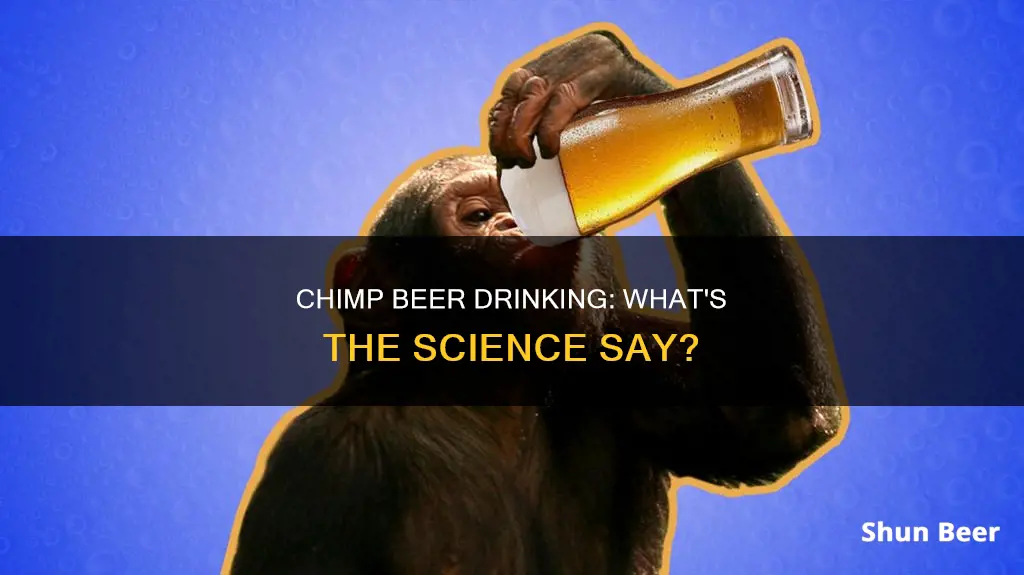
It turns out that chimpanzees do drink alcohol. A 17-year study published in the journal Royal Society Open Science found that chimps in Guinea regularly consumed naturally fermented alcohol. The researchers observed drinking sessions involving adult chimpanzees near Bossou, Guinea, over the course of 17 years. The chimps were found to drink fermented sap from raffia palm trees, which had an alcohol content ranging from 3.1% to 6.9%—the equivalent of a strong beer. The researchers noted that some of the chimps displayed signs of intoxication, including falling asleep shortly after drinking and restlessness. This behaviour provides support for the drunken monkey hypothesis, which suggests that a genetic mutation in the common ancestor of modern apes and humans made it easier for them to break down alcohol, aiding the digestion of fermenting fruit.
| Characteristics | Values |
|---|---|
| Alcohol consumption by chimps | Confirmed |
| Alcohol type | Naturally fermented alcoholic palm wine/sap |
| Alcohol percentage | 3.1-6.9% |
| Container | Leaf sponges |
| Consumption method | Squeezing the leaf sponges in their mouths |
| Consumption frequency | Habitual drinking, multiple sessions per day |
| Consumption quantity | 1 litre per session on average, up to 3 litres |
| Behavioural impact | Restlessness, falling asleep soon after drinking |
| Research location | Bossou, Guinea |
| Research period | 1995-2012 |
What You'll Learn

How do chimps drink?
It is well known that humans' closest living relatives, chimpanzees, share a taste for alcohol. Several studies have observed wild chimps drinking alcoholic palm wine or sap. The drinking behaviour of these chimps has been the subject of research, with scientists aiming to understand how they consume alcohol and the extent of their indulging.
The studies observed chimps in the wild using leaves or "leaf sponges" to drink the fermented liquid. They would fold, chew, or soak the leaves to create a sponge-like pad or cup, which they then dipped into the containers of palm wine or sap and squeezed or tipped into their mouths. This behaviour demonstrates the chimps' understanding of how to use tools to obtain and consume alcohol.
The drinking sessions of the chimps were observed and recorded by researchers over a period of 17 to 20 years, from 1995 to 2012. During this time, they documented multiple instances of chimps climbing up palm trees and using leaves to drink the fermented liquid. The researchers calculated the alcohol content of the drink, which averaged around 3.1% to 6.9% alcohol by volume, comparable to the alcohol content in beer or wine.
The chimps were found to drink significant quantities of alcohol, with some displaying visible signs of inebriation, including falling asleep shortly after drinking or exhibiting restless behaviour. The researchers estimated that some individuals consumed the equivalent of a bottle of wine in a single session.
The findings provide evidence that chimpanzees do not avoid alcohol and are willing to go out of their way to consume it. This supports the "drunken monkey hypothesis," which suggests that a genetic mutation in the common ancestor of modern apes and humans made it easier for them to break down and metabolise alcohol, aiding in the digestion of fermenting fruit.
Drinking Beer in Public: Michigan's Law Simplified
You may want to see also

Why do chimps drink alcohol?
Chimpanzees have been observed drinking alcohol in the wild, specifically, naturally fermented alcoholic palm wine or sap. This behaviour was recorded in a 17-year study of chimpanzees in Bossou, Guinea, published in the journal Royal Society Open Science in 2015. The study found that the chimps had learned to take advantage of containers humans placed in raffia palm trees to collect the alcoholic sap. The sap ferments quickly and the chimps used leaves as sponges to drink the sap, chewing and crushing the leaves into an absorbent pad, then dipping them into the containers and sucking the sweet liquid.
The researchers observed 51 instances of drinking between 1995 and 2012, with 13 chimps using leaf sponges to drink the sap. The sap averaged about 3.1 to 6.9 percent alcohol, which is comparable to the alcohol content of a beer. The chimps often drank large quantities—about a liter (34 ounces, or about three average-size beers) of fermented sap on average. One adult male in particular accounted for 14 of the 51 instances.
The researchers noted that some of the chimps displayed signs of intoxication, including falling asleep shortly after drinking or appearing restless and agitated. While the study does not prove the "drunken monkey hypothesis," it does show that the presence of alcohol does not deter wild chimps from taking a drink. This supports the view that the common ancestor of modern apes and humans became adapted to the consumption of alcohol millions of years ago through a genetic mutation that made it easier to break down alcohol.
The evolutionary benefit of this mutation could be that alcohol provides quick and easy calories, or it may stimulate the appetite, prompting animals to search for more fruit. It is also possible that the consumption of alcohol is a consequence of eating fruit in general, as overripe fruit naturally contains higher levels of ethanol. However, primates are not typically attracted to overripe fruit and rarely eat it. More research is needed to fully understand the drinking habits of non-human primates and the validity of the "drunken monkey hypothesis."
Businesses and Beers: Where Can You Drink?
You may want to see also

How does alcohol affect chimps?
Alcohol affects chimps in a similar way to how it affects humans. A 17-year study published in the journal Royal Society Open Science found that wild chimps in Guinea consumed significant quantities of ethanol and exhibited behavioural signs of inebriation. These signs included falling asleep shortly after drinking and restlessness.
The study, led by Dr Kimberley Hockings from Oxford Brookes University and the Centre for Research in Anthropology in Portugal, observed that the chimps had learned to take advantage of containers humans placed in raffia palm trees to collect the trees' alcoholic sap. The sap, which ferments into palm wine, has an alcohol content ranging from 3.1% to 6.9%, which is equivalent to a strong beer.
The researchers calculated that the chimps drank about a quart (1 litre) per session, with one chimp drinking 3 litres of wine in a single session. The researchers also noted that the chimps often drank the alcohol in large quantities, with one adult male in particular accounting for 14 of the 51 instances of drinking observed.
The findings support the "drunken monkey hypothesis", which proposes that a genetic mutation in the common ancestor of modern apes and humans made it easier for them to break down alcohol, thus aiding the digestion of fermenting fruit. This hypothesis is further supported by the fact that humans, chimps, and African apes share a genetic mutation that emerged about 10 million years ago that helps them metabolise alcohol.
Ice-Cold Beer: Best Served Chilled or Frozen?
You may want to see also

Do chimps get drunk?
Yes, it is true that chimpanzees can and do get drunk. In fact, they have been observed getting drunk in the wild.
In a 17-year study, researchers observed wild chimps in Guinea drinking fermented alcoholic sap from raffia palm trees. The sap was about 3% alcohol by volume, with alcohol content as high as 6.9%—equivalent to a strong beer. The chimps used leaves as sponges to soak up the sap and then squeezed the leaves to drink the sap, consuming as much as a bottle of palm wine in one session. The researchers noted that the chimps displayed signs of intoxication, including falling asleep shortly after drinking and appearing restless and agitated.
This behaviour supports the "drunken monkey hypothesis," which suggests that a genetic mutation in the common ancestor of modern apes and humans made it easier for them to break down alcohol and digest fermenting fruit. The ability to metabolise alcohol may have provided an evolutionary benefit, such as quick and easy calories or stimulation of the appetite.
It is important to note that not all chimps engage in habitual drinking. Some may enjoy it more often than others, while some abstain completely.
Accutane and Alcohol: Is Beer Safe?
You may want to see also

How much alcohol do chimps drink?
It is not possible to give a precise answer to how much alcohol chimps drink, but researchers have observed their drinking habits and quantities consumed. In a study published in the journal Royal Society Open Science, researchers observed drinking sessions involving adult chimpanzees near Bossou, Guinea, over the course of 17 years. They found that the chimps had learned to take advantage of containers humans placed in the raffia palm trees to collect the alcoholic sap. The chimps would use leaves as sponges to drink the sap, and in some cases, they were observed displaying signs of intoxication after consuming large quantities.
The fermented sap has an alcohol content ranging from 3.1% to 6.9%, which is equivalent to a strong beer. On average, a typical drinking session for an adult chimp involves consuming about a liter of sap, which is approximately three beers. However, in some cases, chimps have been observed drinking up to 3 liters of sap in a single session.
The researchers also noted that male chimps were more frequent drinkers than females, with males accounting for 34 out of 51 instances of drinking behavior. One particular adult male chimp was responsible for 14 drinking sessions on his own.
While the exact amount of alcohol consumed by chimps may vary depending on factors such as availability and opportunity, the study provides valuable insights into their drinking habits and preferences.
Beer and Bananas: A Healthy Combo?
You may want to see also
Frequently asked questions
Yes, chimps can drink beer. In fact, they can drink alcohol and have been known to get intoxicated.
In a study published in the Royal Society Open Science journal, researchers observed chimps in Guinea drinking fermented sap from raffia palm trees. The villagers in the area would tap the trees and collect the sap in containers, which the chimps would then drink using leaves as sponges.
Scientists have proposed the "drunken monkey hypothesis", which suggests that a genetic mutation in the common ancestor of modern apes and humans made it easier for them to break down alcohol. This would have made it easier for them to digest fermenting fruit, providing an evolutionary advantage.







